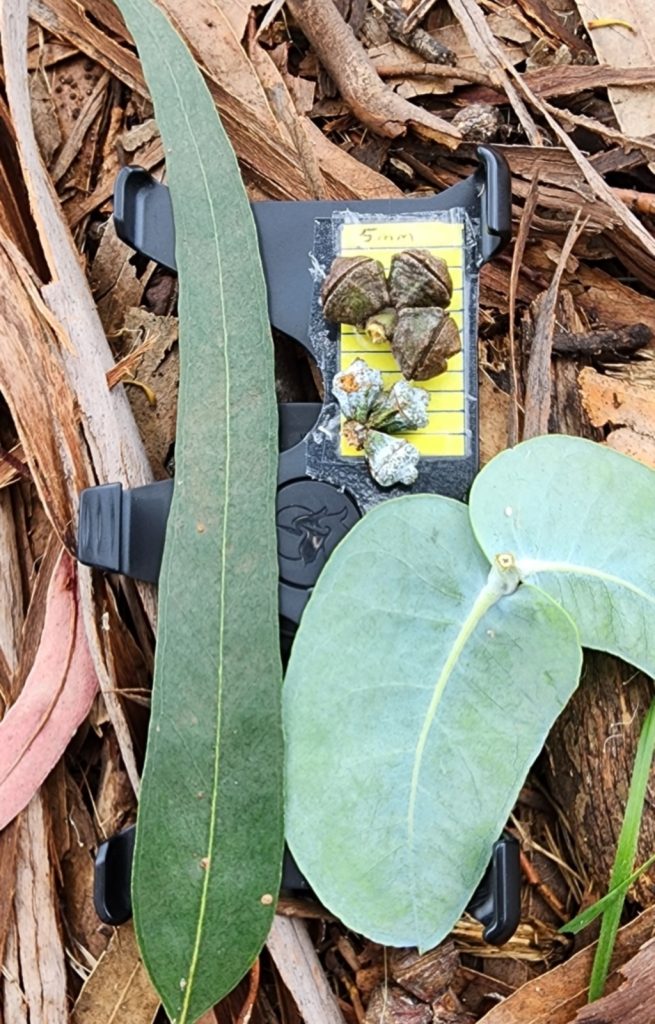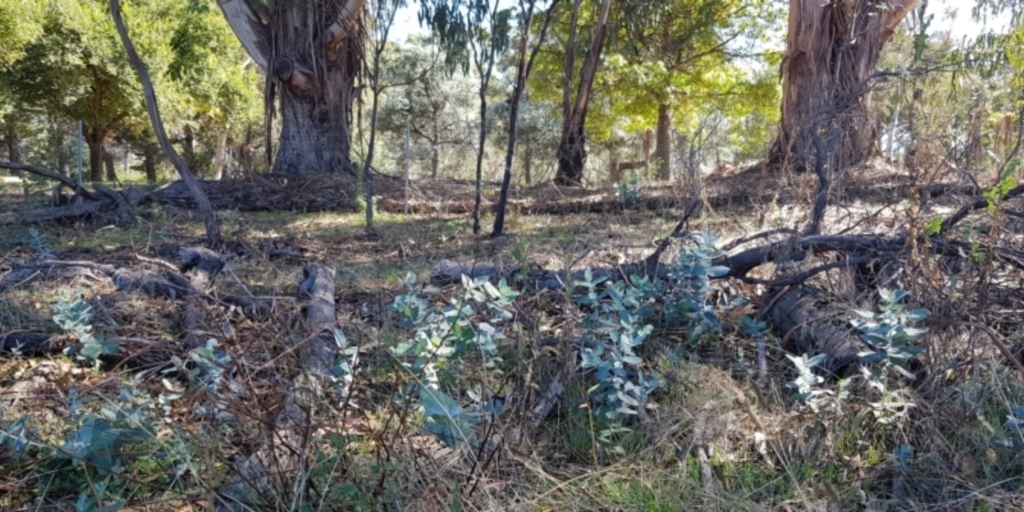
The distinguishing features of Eurabbie, Eucalyptus globulus subsp. bicostata are the warty 2-ribbed blue-green buds, shown in the middle below the fruits, that grow in groups of 3s, the large stalk-less bluish-white juvenile leaves (right) growing opposite on square-sectioned branch-lets, and the leathery, glossy dark-green and up to 30cm long adult leaves (left) (photo Canberra Nature Map).
Friends of Mount Majura will be pulling Southern Blue Gum seedlings from the reserve area adjacent to Valour Park from 9 am to noon on Sunday 21 January in a shady site mostly under trees, and while we are at it, we will also tackle Sweet Briar and other woody weeds.
When: Sunday, 21 January 2024 from 9.00 am to 12 noon.
Where: Meet at the nature park entrance near Tay and Ian Nicol Streets, North Watson; click here to view a map with the meeting and volunteer registration point and blue outlining the target area.
Bring and wear: Sun protection, eye protection, sturdy boots, body covering garden clothing and garden gloves if you have them; we’ll provide tools, herbicide and nitrile gloves to tackle the weeds.
Tip: take some branchlets with juvenile leaves home for their decorative appearance and powerful eucalyptus perfume.
Enquires: secretary@majura.org
The up to 45 m tall Eurabbie or Southern Blue Gum, Eucalyptus globulus subsp. bicostata is a beautiful tree from Victoria’s forests, i.e. not local to this area. So the grassy woodland of the Mt Majura Nature Reserve is not the place for them and we will have a small blue gum forest if the seedlings are not removed. We should do this regularly because the large trees in Valour Park drop their gum-nuts into the reserve.
The species has been extensively planted in the A.C.T. in public spaces such as the ANZAC parade and along Antill Street between Watson and Hackett.

Juvenile Blue Gums lined up in the front along the gully next to Valour Park, and the trunks of two parent trees in Valour park visible in the background (Photo Max Pouwer 2021).
We will also be on the look out for other woody weeds in this area, like Sweet Briar roses (Rosa rubiginosa), Cootamundra Wattles (Acacia baileyana), deciduous trees such as Hawthorns (Crataegus monogyna) and English Elms, (Ulmus procera), and any larger Blue Gums which have escaped previous tree pull sessions. These can all be tackled using the cut and dab method of applying the herbicide glyphosate. The highlighted plant names have links to photographs of them taken by FoMM members and uploaded to Canberra Nature Map.
And other weeds we could come across are St John’s Wort, and the grasses Serrated Tussock and Chilean Needlegrass. These grasses are difficult to identify but some of us have experience to guide us and will be there to help with any unknown plants.
Chemical control of woody weeds using the cut & daub method.
Cut stems close to ground level and immediately treat cut surface with herbicide glyphosate (Roundup or equivalent product) applied at high concentration i.e. 1 part glyphosate : 2 parts water; apply herbicide mix with a hand-spray or paint the cut surface with a dabber.
The plant’s natural protective mechanism acts very quickly to seal off the cut surface and this stops herbicide penetration into the sap stream. It is therefore important to treat the cut surface immediately, i.e. within 30 seconds after cut; the longer the treatment is delayed, the poorer the result will be. If necessary cut and daub each stem of multi-stemmed plants separately to avoid delayed herbicide treatment.


